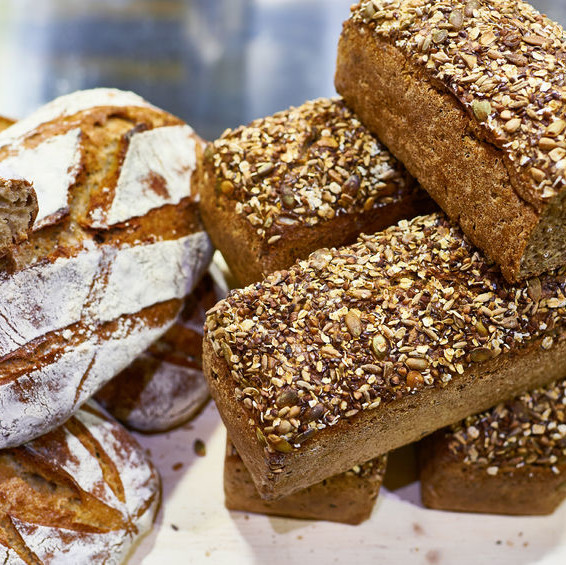
Is your bakery focused on producing whole grain products? Consumers are turning away from baked goods produced with refined flour and seeking healthier alternatives found in whole grain foods. Whole grains are grains that are consumed in their original form without being refined. They contain their original parts such as the bran, germ, and endosperm in the same proportions as when the grain is in the field.1 Some examples of whole grain ingredients are millet, barley, rice, and whole wheat flour.
Consumption of these grains have many health benefits that can be claimed on your product’s label.
Whole grains are rich in vitamins, minerals, and dietary fiber. They provide a good source of phytochemicals and micronutrients, B vitamins, magnesium, and selenium.1 Whole grains play a significant role in the reduction of body weight, cutting hypertension and decreasing blood pressure, preventing constipation, stabilizing energy in the body, relieving menstrual cramps and tension, and improving colon health, among other benefits.4
According to the FDA’s Food Modernization Act, food manufacturers who use whole grains may make the following health claims on labels:2
| Approved Claims | Food Requirements | Claim Requirements | Model Claim Statements |
|---|---|---|---|
| Whole Grain Foods and Risk of Heart Disease and Certain Cancers
(Docket No. 1999P-2209) |
Contains 51 percent or more whole grain ingredients by weight per RACC, and
Dietary fiber content at least:
|
Required wording of the claim:
“Diets rich in whole grain foods and other plant foods and low in total fat, saturated fat, and cholesterol may reduce the risk of heart disease and some cancers.” |
NA |
| Whole Grain Foods with Moderate Fat Content and Risk of Heart Disease
(Docket No. 03Q-0547) |
Contains 51 percent or more whole grain ingredients by weight per RACC, and
Dietary fiber content at least:
|
Required wording of the claim:
“Diets rich in whole grain foods and other plant foods and low in total fat, saturated fat, and cholesterol may help reduce the risk of heart disease.” |
Table excerpted from FDAMA 11. Appendix C: Health Claims.2
In addition, there are various stamps used to identify whole grain products. The stamps make it easier for consumers to search for the whole grain foods they want in a baked good. There are three common stamps of whole grain foods in use:3
- 100% Stamp: whole grain products that have whole grains only
- 50% Stamp: whole grain products that contain 50% or more whole grains
- Basic Stamp: products in which there are at least 8g of whole grains per serving
The above are examples of packaging and labeling established by the Whole Grains Council.3
Marketing Whole Grain Products
Bakers producing whole grain foods may adopt the new labeling of grains to ensure that their products are unique and easily identified by consumers. Labeling is considered the first marketing tool that every baker should consider. It needs to be attractive and eye-catching, while at the same time communicating the content of nutrients as explained above.
The whole grain labeling system will let consumers know the amount of grains in the product, is an effective advertising tool, makes it easier for consumers to distinguish one’s products from those of competitors, and is a legal requirement.5
References
- Bakerpedia. Whole Grains | Baking Ingredients. https://bakerpedia.com/ingredients/whole-grains/. Accessed 28 June 2017.
- Center for Food Safety and Applied Nutrition. Labeling & Nutrition – Guidance for Industry: A Food Labeling Guide (11. Appendix C: Health Claims). U S Food and Drug Administration Home Page. Center for Food Safety and Applied Nutrition, Jan. 2013. www.fda.gov/food/guidanceregulation/guidancedocumentsregulatoryinformation/labelingnutrition/ucm064919.htm. Accessed 28 June 2017.
- Owen, A. New 50%+ Whole Grain stamp highlights products made primarily with whole grains, to meet heightened consumer interest. The Whole Grains Council. Oldways, 28 Feb. 2017. https://wholegrainscouncil.org/new-50-whole-grain-stamp-highlights-products-made-primarily-whole-grains-meet-heightened-consumer. Accessed 28 June 2017.
- Slavin, J. Whole grains and human health. Nutrition Research Reviews. U.S. National Library of Medicine, 17 June 2004. www.ncbi.nlm.nih.gov/pubmed/19079919. Accessed 02 July 2017.
- The importance of food labeling. Entrepinoys Atbp. Business Ideas Philippines. 29 June 2014. www.mixph.com/the-importance-of-food-labeling/. Accessed 03 July 2017.

